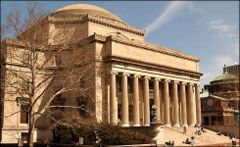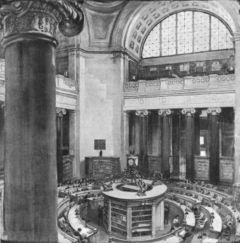Low Library
- See also Wikipedia's article about "Low Library".

Low Memorial Library, despite its name, is neither low nor a library.
Low actually sits high up on the platform constructed for original campus north of 116th Street (now College Walk), and serves as a major focal point and symbol of the university. It was named after President Seth Low's father, Abiel Abbot Low.
It was the university's main library on the Morningside Heights campus, until the completion of Butler Library, but it is now an administrative building, housing President Bollinger's office, the Committee on Global Thought, the Public Safety office, and the Visitor's Center. Its function is a point of confusion for many visitors to campus, since the inscription on its frieze reads "The Library of Columbia University".
On warm days, students often congregate on the Low Library steps around the statute of Alma Mater, which lines up symmetrically with Low and serves as one of the university's other great symbols.
Contents
History
Low originally served as Columbia's main library and was the first academic building on Columbia's Morningside Heights campus. It was financed by Seth Low's personal fortune; he contributed $1 million dollars after alumni refused to foot the bill, which is why he got to choose the name.
The building was designed by McKim, Mead, and White, the main architects of most of the Morningside campus. As part of their original plan, the architects built the building quite tall for buildings of its time, with the fact that Columbia would eventually be part of a large city in later years in mind. Elements of Rome's Pantheon (notably the dome) and the Baths of Diocletian (the windows) inspired the design, and the layout was patterned after a Greek cross. Its columns were fashioned in the ionic order, which was considered appropriate for an institution of arts and letters. Construction was completed in 1897.
The building served as Columbia's main library until the completion of the larger Butler Library in 1934.
During the 1968 protests, Low was occupied by rebellious students, who seized President Grayson Kirk's offices to look for incriminating files.
The University Archives remained in Low until 2008, but moved to the sixth floor of Butler to make way for the Committee on Global Thought, rendering Low now completely devoid of the books it was built to contain.
The Dome
Low Library's dome is rumored to be the largest freestanding granite dome in the United States. It is the most obvious part of the building to take its inspiration from the Pantheon.
According to legend, the first student to scale the dome was campus explorer Ken Hechtman, in 1987. He noted that he faced many obstacles in doing so, and that tags from the 1920s indicated that student groups had tried but failed. Today, access to the dome is no longer that uncommon for intrepid students.[1]
Interior

Entryway
Among the statues in Low's entryway are busts of Zeus and Apollo and a white marble bust of Pallas Athena, modeled on the Minerve du Collier at the Louvre (donated by Jonathan Ackerman Coles CC 1864).
The Rotunda
The Low Library Rotunda is the university's primary ceremonial space on campus. It hosts major prize ceremonies such as the Pulitzers and Bancrofts, hosts dignitaries and heads of state during the World Leaders Forum, and pretty much anything that's fancy and formal. A giant mural on the third floor of Butler Library depicts the ceremony held to honor the Queen of England on her visit to Columbia.
The rotunda has 16 columns made of green marble from Ireland and topped by golden capitals. Above each are pedestals for statues, but only four were ever erected.[2] On the north side of the Rotunda from left to right are:
- Euripedes (donated by Charles McKim, a copy of the Giustinian Euripides in the Vatican)
- Demosthenes (donated by W. Bayard Cutting CC 1869, a copy of the Vatican Demosthenes)
- Sophocles (donated by Dr. George G. Wheelock CC 1864, a copy of the statue in the Lateran Museum)
- Augustus Caesar (donated by F. Augustus Schermerhorn CC 1868, a copy of the statue in the Louvre)
They're all carved from Istrian marble.
The Trustees' Room
One of the more interesting parts of Low Library is the Trustees' Room, immediately on the right in the lobby. As the name suggests, it's the meeting place for Columbia's trustees. The wood paneled room includes a fireplace inlaid with the cornerstone of College Hall, above which hangs a portrait of the first president of King's College, Samuel Johnson, as well as the original King's Crown. In addition, there are portraits of past chairmen of the board of trustees, and every chair in the room has a nameplate designating which current trustee sits there during meetings.
Original layout
Long ago, when Low still functioned as a library, the rotunda was the main reading room and held the circulation desk. The east wing of the main floor, currently the Committee on Global Thought's office, housed the architecture library. An indication of this legacy is visible in the molding around the room's ceiling, featuring the names of architects from antiquity and the Renaissance. The collection eventually moved to Avery Hall, which was built for the specific purpose of housing the collection.
The north wing of the library, now the Faculty Room, which houses a permanent exhibit of Chinese artifacts, served as the law library until Kent Hall was constructed; the law library is now located, with most of the rest of the law school, in Jerome Greene Hall.
Space reservations
Contact Joseph Sabbat, Space & Reservations Coordinator, Low Memorial Library on 212-854-1874.



